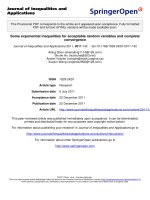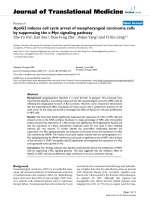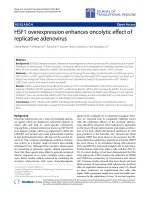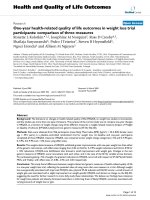Báo cáo hóa học: " Laser-Induced, Polarization Dependent Shape Transformation of Au/Ag Nanoparticles in Glass" docx
Bạn đang xem bản rút gọn của tài liệu. Xem và tải ngay bản đầy đủ của tài liệu tại đây (295.78 KB, 4 trang )
NANO EXPRESS
Laser-Induced, Polarization Dependent Shape Transformation
of Au/Ag Nanoparticles in Glass
G. Seifert Æ A. Stalmashonak Æ H. Hofmeister Æ
J. Haug Æ M. Dubiel
Received: 13 May 2009 / Accepted: 29 July 2009 / Published online: 11 August 2009
Ó to the authors 2009
Abstract Bimetallic, initially spherical Ag/Au nanopar-
ticles in glass prepared by ion implantation have been
irradiated with intense femtosecond laser pulses at inten-
sities still below the damage threshold of the material
surface. This high-intensity laser processing produces
dichroism in the irradiated region, which can be assigned to
the observed anisotropic nanoparticle shapes with prefer-
ential orientation of the longer particle axis along the
direction of laser polarization. In addition, the particle sizes
have considerably been increased upon processing.
Keywords Alloy nanoparticles Á Glass Á Laser
irradiation Á Femtosecond laser processing Á Dichroism
Nano-sized metal particles embedded in glass are of great
interest because of their potential application as non-linear
material for photonic devices [1, 2]. The non-linear prop-
erties of nanocomposite glasses equipped with such parti-
cles are induced by the surface plasmon resonance at the
interface between particles and glass matrix. This means
that the optical effects in the spectral region around the
surface plasmon resonance result from an electric field
enhancement or a quantum confinement. Thus, applications
are possible as in integrated photonic networks, in nano-
electronics, for surface enhanced Raman scattering, for up-
conversion processes and laser materials. Recently, the
preparation of specific bimetallic nanoparticles like core-
shell structures has been intensively investigated because
of the far-reaching possibilities to modify the macroscopic
properties [3–6]. A special way to extend the range of
manipulating the optical properties of such nanocomposite
glasses can be achieved by a development of central voids
within the particles. There are known some first examples
for hollow nanoparticles in glass that were prepared by
sequential implantation of two different metal ions [6–8].
A further degree of freedom introducing anisotropic
optical properties is the method of femtosecond laser pulse-
induced shape transformation of the nanoparticles which
has been studied intensively in recent years [9–11].
Depending on the actual irradiation parameters, uniformly
oriented prolate or oblate nanoparticles can be prepared,
whose orientation is controlled by the laser polarization
[12]. So far these effects have been demonstrated for Ag
nanoparticles at low concentration. In this Letter, we will
demonstrate that a similar shape modification of initially
spherical bimetallic and hollow Ag/Au nanoparticles in
soda-lime glasses is possible by irradiation with femto-
second laser pulses at high intensity, but below damage
threshold; in particular, it will be shown that anisotropic
particle shapes or nearly linear arrangements of nanopar-
ticles with preferential orientation along the direction of
laser polarization can be fabricated with the help of this
irradiation technique.
The samples used for this study were sheets of soda-lime
glass containing (in mol%) 72.4% SiO
2
and 14.4% Na
2
Oas
main components, which were exposed subsequently to
Au
?
(150 keV) and Ag
?
(100 keV) ion implantation at
G. Seifert (&) Á A. Stalmashonak
Institut fu
¨
r Physik, Fachgruppe Optik, Martin-Luther-Universita
¨
t
Halle-Wittenberg, Hoher Weg 8, 06120 Halle, Germany
e-mail:
H. Hofmeister
Max-Planck-Institut fu
¨
r Mikrostrukturphysik, Weinberg 2,
06120 Halle, Germany
J. Haug Á M. Dubiel
Institut fu
¨
r Physik, Fachgruppe ANM, Martin-Luther-Universita
¨
t
Halle-Wittenberg, Friedemann-Bach-Platz 6, 06099 Halle,
Germany
123
Nanoscale Res Lett (2009) 4:1380–1383
DOI 10.1007/s11671-009-9408-5
room temperature. By this sequential high-dose ion
implantation of Ag
?
and Au
?
, metal particles have been
formed in a surface-near region of the soda-lime silicate
glass. The dose of implanted ions was 4 9 10
16
ions/cm
2
for each type of ions (for further details see [8]). To char-
acterize the surface plasmon resonance due to the metal
nanoparticles formed in the implanted areas the optical
density of glass samples was recorded by means of a Perkin-
Elmer spectrometer in the wavelength range of 250–
900 nm. These samples were irradiated by linearly polar-
ized laser pulses of 150 fs temporal width at a wavelength
k = 550 nm. This wavelength is the sum frequency of a
1 kHz repetition rate Ti:Sapphire laser at k = 800 nm and
the idler (k = 1,760 nm) of a Travelling-wave Optical
Parametric Amplifier of Superfluorescence (TOPAS). The
laser beam was focused on the sample to a spot size of
*100 lm. Moving the sample continuously on a motorized
X–Y translation stage, several parallel lines of *1.5 mm
length and 150 lm lateral distance have been inscribed in
the glass at a velocity of 0.5 mm/s, corresponding to, on
average, 200 laser pulses hitting each spot within the lines.
The polarization direction of the laser was parallel to the
lines (writing direction).
The effect of irradiating the sample in the described way
with average single pulse energy of 20 lJ is shown in
Figs. 1 (microscope images) and 2 (optical absorption
spectra). The lines prepared by high intensity fs laser
irradiation exhibit a certain subdivision into a few parallel
traces of decoloration as well as, at a few positions along
the line center, some damage at the very glass surface. In
the central region (width *50 lm) the lines clearly show
dichroism (see Figs. 1, 2). In the outer regions of the lines
there is still a color change visible, but the dichroism
decreases continuously to that of the original glass region.
To evaluate the nanoscopic background of the observed
optical changes, the parameters mean size, size distribution,
shape, and penetration depth of the metal particles have been
examined by transmission electron microscopy (TEM) using
a JEM 1010 operating at 100 kV and a JEM 4010 operating
at 400 kV. For this purpose, planar and cross-section prep-
aration were applied including mechanical grinding, pol-
ishing and argon ion-beam etching followed by deposition
of a thin carbon film on both sides. For the samples of this
study, prepared by applying an ion dose of 4 9 10
16
/cm
2
for
both of the metals, a particle-containing region has been
obtained that extends from the very glass surface to a depth
of about 135 nm. TEM imaging of cross-section samples
reveals that this particle layer exhibits a non-uniform spatial
distribution of particles as already reported earlier [8]. In the
middle of the particle layer mainly larger particles are sit-
uated whose anomalous image contrasts point to the pres-
ence of voids in their interior as may be recognized from the
TEM image of a planar preparation sample shown in Fig. 3.
While for the entire set of particles present in the layer a
mean size of 5.34 ± 3.89 nm has been determined, the
mean outer diameter of the void-containing particles
amounts to 16.2 nm. Altogether the particle sizes range from
Fig. 1 Optical micrographs of the Au/Ag nanoparticles containing
glass after laser irradiation recorded using a non-polarized, and b, c
polarized light, respectively
400 450 500 550 600 650 700
0.0
0.2
0.4
0.6
0.8
1.0
Optical Density
Wavelength [nm]
Pol. || Laser
Pol. ⊥ Laser
original particles
Fig. 2 Optical density within the central region of irradiated glass
measured before (original glass, solid line) and after laser irradiation
with polarized light, parallel (dotted) or perpendicular (dashed) with
respect to laser pulse polarization and line direction (see Fig. 1). The
spectra of non-irradiated samples are identical for parallel and
perpendicular polarization
Fig. 3 TEM micrograph of the 4 9 10
16
/cm
2
Ag
?
and 4 9 10
16
/cm
2
Au
?
ion implanted sample
Nanoscale Res Lett (2009) 4:1380–1383 1381
123
about 1.5–24 nm. The frequency of the surface plasmon
resonance of the non-irradiated glass (see Fig. 2) appearing
between those of pure Ag and Au particles demonstrates the
formation of Ag–Au alloy nanoparticles. The relation of
concentrations of both elements incorporated into the
nanoparticles should be *1:1 corresponding to calculations
of theoretical spectra [13] and to experiments by anomalous
small angle X-ray scattering [14].
The above-described ultrashort laser pulse processing of
this sample resulted in a totally different appearance of the
structural characteristics of this particles-in-glass compos-
ite material which, however, is restricted to those regions
where the laser lines have been inscribed into the particle
layer. By careful target preparation we achieved to place
the position of the hole at the edge of one of these lines;
this allowed us to image within one specimen regions
without laser irradiation as well as regions where the
maximum laser pulse intensity had been applied. The TEM
examination reveals that ultrashort laser pulse processing
causes fundamental changes in size, shape, arrangement
and configuration of the metal nanoparticles in the irradi-
ated regions (see Fig. 4), whereas no changes can be
observed in non-irradiated regions. In the center of the
irradiated regions the particles exhibit distinctly increased
size, but none of them contains a void. Most of the larger
particles are elongated nearly along a common direction
parallel to the laser lines inscribed (and thus along the laser
polarization vector). The elongated particle shapes may be
described as spheroidal, but with a certain degree of
irregularity. Altogether the particle dimensions range from
about 4.4 to 52.6 nm for the minor axis (mean value
16.68 ± 8.69) and from 5.6 to 79.6 nm for the major axis
(mean value 20.98 ± 13.47). The aspect ratio (i.e., the
ratio of major to minor axes lengths) of the particles
increases nearly linearly from a value of 1 for particles of
about 4.7 nm diameter to a value of 1.5 for particles of
about 60.4 nm diameter (these diameters refer to spheres of
the same volume as the spheroids have). The total increase
in particle size compared to the initial situation in the
sample before irradiation corresponds to a more than ten-
fold volume increase for the individual particle. So, the
laser processing resulted in a totally different appearance,
not only the particle dimensions have increased by a factor
of 3, but also the size distribution has become a little bit
narrower and lost part of its asymmetry, and, what is the
important issue in this result, shape and arrangement of the
particles deviate from the previous isotropic appearance.
On the other hand the optical absorption remains fairly
constant or even decreases indicating that the total amount
of silver and gold does not grow. So it can be concluded
that the volume increase of the particles is compensated by
a simultaneous decrease of their number. The optical
spectra also show that the composition of alloy nanopar-
ticles should be similar to that before the irradiation. There
are only slight shifts due to variations in sizes of particles
and concentrations of elements within the particles.
Finally, we want to discuss briefly which physical
mechanisms may lead to the observed shape changes of
bimetallic nanoparticles upon intense fs laser irradiation, in
particular explaining the preferential orientation of elon-
gated particles more or less arranged parallel to the laser
polarization. The shape changes observed here can be
compared to similar previous results obtained on two quite
different types of metal-dielectric nanocomposites. The
first type of material is glass containing low concentration
of Ag nanoparticles. For such systems it has been found
that only the individual particle and its immediate sur-
roundings are affected by laser-induced modifications. The
sequence of processes there starts with field-driven electron
emission from the particle, followed by electron trapping in
the glass matrix, ion emission, their local recombination
with trapped electrons, and diffusion and precipitation of
Ag atoms at the poles of the particle in the transiently
heated nearest shell of the matrix [11]. The second type of
material studied previously is plasma polymer embedding a
quasi 2-dimensional metal island film. Irradiating these
systems with similar parameters as in this work, a grating-
like superstructure oriented along the laser polarization
with a typical period of 2/3 of the laser wavelength has
been observed, where stripes of unchanged metal nano-
structure (percolation region) are alternating with stripes of
coagulated larger, spherical particles [15]. The explanation
for these self-organized structures comprises spatially
modulated energy input in the metal layer by interference
of the incoming laser light with the scattered surface wave,
where statistical inhomogeneities of the sample provide a
feedback, so that the structures are becoming more pro-
nounced and regular shot by shot.
Fig. 4 TEM micrograph of the above sample upon ultrashort laser
pulse irradiation
1382 Nanoscale Res Lett (2009) 4:1380–1383
123
The shape changes reported here are somehow inter-
mediate between the abovementioned limiting cases.
Comparing the situation with the plasma polymer samples,
we here also observe a large increase of particle sizes, but
no regular superstructure. Comparing with isolated Ag
nanoparticles in glass, we also find individual non-spheri-
cal shapes with the long axes oriented preferentially along
the laser polarization; but, in addition, particles are grow-
ing and sometimes merging, preferentially in situations
where together they form a coagulated particle with longer
axis along the laser polarization.
From these considerations we conclude that the laser-
induced shape changes of bimetallic nanoparticles are
initiated by the same mechanisms as in the case of low-
concentrated Ag nanoparticles, i.e., directional electron
emission and capture in the glass matrix, followed by the
processes listed above. The main difference appears to
come from the higher metal concentration leading to spa-
tially and temporally more extended regions of high tem-
perature around metal particles in the matrix, enabling
much larger diffusion distances of electrons and metal ions
or atoms. It cannot be decided at present if, in addition to
the basic mechanism of particle reshaping during laser
irradiation (migration of individual atoms or ions), also
processes like migration and coalescence of very small
particles contribute to the observed particle growth. The
reason is that all processes are started by an *100 fs laser
pulse; then the surrounding glass is heated within a few ps
and cools down again by heat conduction within a few ns
[16]. Particle formation or growth under such strongly non-
equilibrium conditions has, to the best of our knowledge,
so far not been modeled theoretically.
Still, however, the local trapping sites for electrons in
glass are obviously a necessary prerequisite for shape
anisotropy of the particles. This is confirmed by the lack of
similar shape anisotropy of the metal particles after fs
irradiation in plasma polymers. Furthermore, the tempera-
ture increase during laser irradiation within the particle
regions explains the transformation of hollow particles into
solid ones because of their thermal instability [17, 18]. The
vacancies leave the central void toward the outer surface
and the hollow region disappears at elevated temperatures.
The laser-induced changes of shape and configuration of
nanoparticles described above can also explain the slight
blue shift of the surface plasmon resonance observed for
perpendicularly polarized light as well as the lacking red-
shift for parallel polarization (as shown in Fig. 3). From the
reduced total optical density after laser treatment, one can
conclude a reduced concentration of precipitated particles
compared with the nanocomposites before irradiation. That
is, obviously the recombination of emitted ions with trap-
ped electrons is not completed. While, however, the
probability for emission during interaction with an
ultrashort laser pulse is the same for Au and Ag ions, the
mobility of Au in the glass matrix is considerably less than
that of Ag species. This difference should also affect the
amount of both elements being incorporated into the par-
ticles again; so in the end the concentration ratio in the
particles will be shifted toward Ag atoms, and this will
shift their plasmon resonances toward shorter wavelengths.
In conclusion, we have shown that spherical, bimetallic
Au/Ag nanoparticles in glass at high concentration can be
transformed to anisotropic shapes (accompanied by size
increase) preferentially oriented along the direction of the
linear laser polarization. The mechanism appears to be
similar to that observed for silver nanoparticles in glass at
low concentration, but with additional effects like coales-
cence caused by the close proximity of the particles. Overall,
the demonstrated high-intensity laser processing is a prom-
ising and flexible technique to design the linear and non-
linear optical properties of metal-glass nanocomposites.
Acknowledgments The authors would like to thank the Institute of
Solid State Physics of the Friedrich Schiller University of Jena for
implantation of glass samples.
References
1. F. Gonella, P. Mazzoldi, Metal nanocluster composite glasses, in
Handbook of nanostructured materials and nanotechnology, vol.
1, ed. by H.S. Nalwa (Academic press, London, 2000), p. 81
2. G. Fuxi, L. Xu, Photonic glasses (World Scientific, Singapore,
2006)
3. N. Toshima, T. Yonezawa, New J. Chem. 22, 1179 (1998)
4. S. Hannemann, J D. Grunwaldt, F. Krumeich, P. Kappen, A.
Baiker, Appl. Surf. Sci. 252, 7862 (2006)
5. T. Yonezawa, Synthesis and characterization of core-shell
structured metals, in Self-Organized Nanoscale Materials, ed. by
M. Adachi, D.J. Lockwood (Springer, New York, 2006), p. 251
6. A. Meldrum, L.A. Boatner, C.W. White, R.C. Ewing, Mat. Res.
Innovat. 3, 190 (2000)
7. X. Xiao, C. Jiang, F. Ren, J. Wang, Y. Shi, Solid State Comm.
137, 362 (2006)
8. M. Dubiel, H. Hofmeister, E. Wendler, J. Non-Cryst. Solids 354,
607 (2008)
9. M. Kaempfe, T. Rainer, K J. Berg, G. Seifert, H. Graener, Appl.
Phys. Lett. 74, 1200 (1999)
10. A.V. Podlipensky, V. Grebenev, G. Seifert, H. Graener, J.
Luminesc. 109, 135 (2004)
11. A.A. Unal, A. Stalmashonak, G. Seifert, H. Graener, Phys. Rev. B
79, 115411 (2009)
12. A. Stalmashonak,G. Seifert, H. Graener, Opt. Lett. 32, 3215 (2007)
13. G. Suyal, M. Mennig, H. Schmidt, J. Mater. Science 38, 1645
(2003)
14. J. Haug, H. Kruth, M. Dubiel, H. Hofmeister, S. Haas, D. Tat-
chev, A. Hoell, Nanotechnology (submitted)
15. A.Kiesow, S. Strohkark,K. Lo
¨
schner, A. Heilmann,A. Podlipensky,
A. Abdolvand, G. Seifert, Appl. Phys. Lett. 86, 153111 (2005)
16. A. Stalmashonak, A.A. Unal, H. Graener, G. Seifert, J. Phys.
Chem. C 113, 12028 (2009)
17. A.M. Gusak, T.V. Zaporozhets, K.N. Tu, U. Go
¨
sele, Phil. Mag-
azine 85, 4445 (2005)
18. K.N. Tu, U. Go
¨
sele, Appl. Phys. Lett. 86, 093111 (2005)
Nanoscale Res Lett (2009) 4:1380–1383 1383
123









